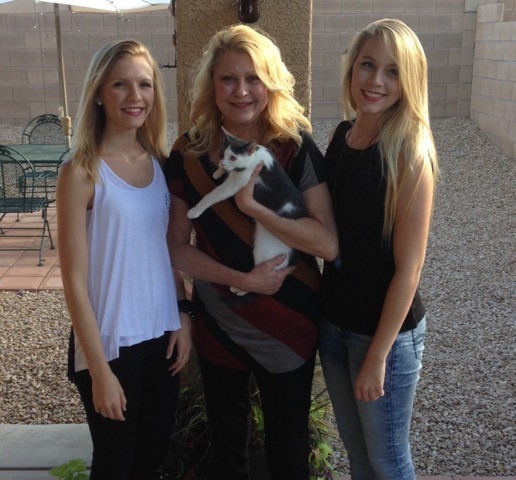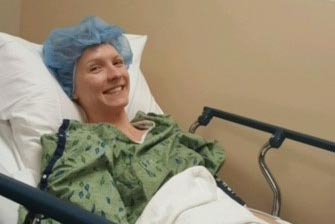They're only in their early 20s, but they're already veterans of extensive surgery. It just might save their lives. At the very least, it will dramatically reduce their risk of developing breast cancer.
In February 2017, Chandler natives Sarah and Ashley, 22 and 24, underwent double mastectomies and breast reconstruction at HonorHealth Virginia G. Piper Surgery Center in Scottsdale.
Although neither sister had a breast cancer diagnosis, each carries the BRCA2 gene mutation. That boosts their lifetime risk for breast cancer to 40-80% and their lifetime risk for ovarian cancer to 15-40%.
The sisters decided to put the threat of breast cancer behind them by having double preventive mastectomies.
Mom's cancer journey started at 36

Their late mother, Carrieanne, received her first breast cancer diagnosis at 36 and required chemotherapy and radiation. A few years later, she developed a new cancer in the opposite breast, requiring additional surgeries and further chemotherapy and radiation. After her second breast cancer, she was tested and found to have the BRCA2 mutation. She passed away at the age of 51. Her cause of death wasn't breast cancer, but the toll of its treatment over the years contributed to her passing, said Ashley.
"I remember her strength," she said of her mother. "Most of all, I remember her laugh — she had quite a sense of humor. And I remember her ability to take care of us as a mother despite her disease; she was the best mom!"
Three years ago, at 21, Ashley had a breast mass. During her workup, she opted for genetic counseling and testing, discovering she carried the same BRCA2 mutation that had caused her mother's breast cancers. Luckily, Ashley's biopsy was benign. However, having the breast cancer mutation required frequent follow-up ultrasounds, breast MRIs and checkups.
"At the last ultrasound, I realized how anxious I was getting," said the ASU grad and manager of a family medicine office in Chandler. "I wanted to have the relief of getting rid of the problem."
In 2015, her younger sister decided to have genetic testing as well. She, too, had the BRCA2 gene mutation. "I wasn't very surprised," Sarah said. "Ashley already had been told she had it. I just kind of knew I had it, too." Thankfully, their brother Seth, 26, tested negative for it.
A University of Arizona senior majoring in veterinary science, Sarah was only 6 when her mother got her first breast cancer diagnosis. "We were always going to hospitals and visiting doctors," she said. She didn't want her adult life to be a repeat of that.
‘I want to be healthy'
Friends and family told the sisters they were brave to have the preventive mastectomies. "It's not really bravery," said Sarah. "I want to be healthy. I want to live life without the risk of getting cancer. I'm excited to get relief from the fear of cancer."
Learn more:
Ashley said it was a huge decision to have the surgery, but something they needed to do. "We felt the pressure and decided to do it now while we're young and can recover quickly," she said. "This was the best time to tackle it before Sarah went off to vet school where it'd be more difficult to get time away from her studies. We figured if we were going to do it, we'd do it together."
Linda Liu, MD, a breast surgeon on the HonorHealth Medical Staff, offered the sisters a variety of options to deal with the BRCA2 mutation:
- Watchful waiting with exams and advanced imaging such as ultrasound and MRI screenings to allow early detection. The drawback? This option can be nerve-wracking if you have a lump and have to wait for test results.
- Surgical or medical treatment to dramatically reduce their risks of developing breast cancer. Surgery would involve removing both breasts.
- Taking tamoxifen for five years could reduce the risk of breast cancer by half. Unfortunately, this medication often causes hot flashes.
- Oophorectomy, surgical removal of ovaries and fallopian tubes, is strongly recommended because ovarian cancer is difficult to detect. This surgery reduces the risk of ovarian cancer by 90% and is recommended when the individual is done with childbearing, between the ages of 35 and 44 (earlier for BRCA1 carriers). If a woman undergoes this procedure in her 30s or 40s, the estrogen reduction can effectively decrease breast cancer by 30-60%. Ashley and Sarah were advised to have children before 40 and then have their ovaries and fallopian tubes removed.
- Prophylactic nipple-sparing double mastectomies. This would lower the risk of breast cancer to 0-5% but would require complex surgery with reconstruction.
Dr. Liu acknowledged that the double mastectomy option "had to be scary for Sarah and Ashley — especially without their mom here to help them through it.
"Generally, I don't recommend this surgery this early in life unless the patients are very set on it," she said. "A woman has to be 110% sure about it, given all the emotional requirements and consequences. I leave it up to the woman to decide, but she has to be absolutely ready, and I encourage her to think very carefully before choosing this treatment."
The BRCA2 mutation tends to have a less aggressive pattern of breast cancer, and Dr. Liu feels comfortable closely watching these patients. "I always reassure my patients that it's safe to wait and watch, until they're ready to make the decision for surgery," she continued. In contrast, the BRCA1 mutation can cause a more aggressive breast cancer that requires chemotherapy, so prophylactic mastectomy in patients with BRCA1 is more likely to be encouraged.
"Ashley and Sarah have so many things they want to achieve in life that they didn't want surgery, recovery or breast cancer to derail their goals," Dr. Liu said. "They didn't make their decision to have surgery out of fear. They were very analytical and poised. The fact that they're perfectly healthy helped them recover quickly."
They could wake up whole

Dr. Liu worked in tandem with board-certified plastic surgeon Bryan Gawley, MD, a breast reconstruction expert and independent member of the HonorHealth Medical Staff. During their double mastectomies, he was able to perform immediate breast reconstruction using implants, essentially creating new breasts in a day for both sisters.
"A majority of patients undergoing breast reconstruction today often require multiple stages, beginning with the placement of temporary adjustable implants or tissue expanders," Dr. Gawley said. "With Ashley and Sarah, I could go directly to a permanent implant at the time of mastectomy. They could wake up whole."
Psychologically, that's a huge boost, he noted. "Aesthetically, patients' reconstructed breasts look natural and often better than before surgery."
Breast surgeons today are increasingly performing nipple/areola-sparing mastectomies. Because Ashley and Sarah did not have cancer that required chemo or radiation treatments, and because they have young, healthy skin, they were the perfect candidates for immediate direct-to-implant reconstruction. To ensure there was no trace of cancer in the nipples, a pathologist examined them during the mastectomies, issuing an all clear.
Beyond grateful
The two young women are beyond grateful that everything went well. "We couldn't be happier," said Ashley. "Our nurses took such good care of us." She appreciated their flexibility, too, when the sisters simply had to see each other later that night.
After passing post-surgery milestones, Sarah got the OK to visit her sister. "Andrea, a nurse's aide, was right beside me as I walked into Ashley's room," said Sarah. "She didn't let me out of her sight. When Ashley and I saw each other, we were giggly. It was such a relief. I was just super proud of her."
Both women went home the next morning to recuperate. The sisters' much-anticipated new life without the worry of breast cancer began quickly for Sarah. Only eight days after surgery, she interviewed for veterinary school at a Valley university.